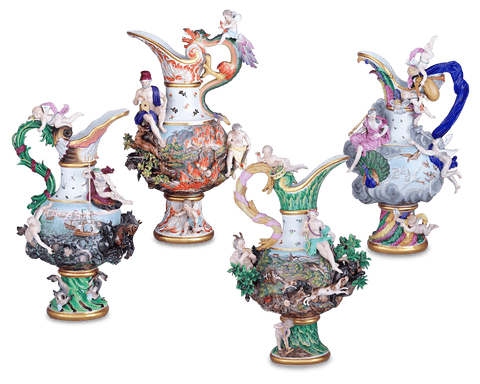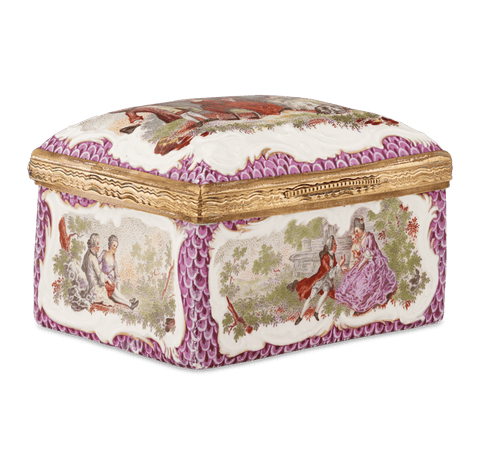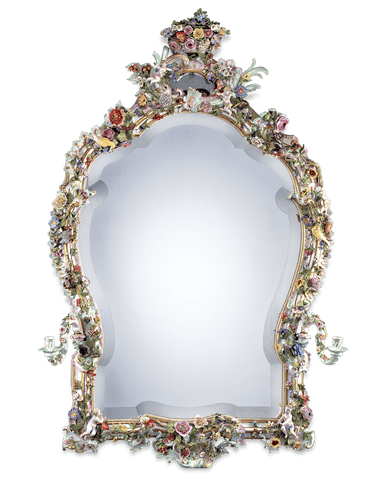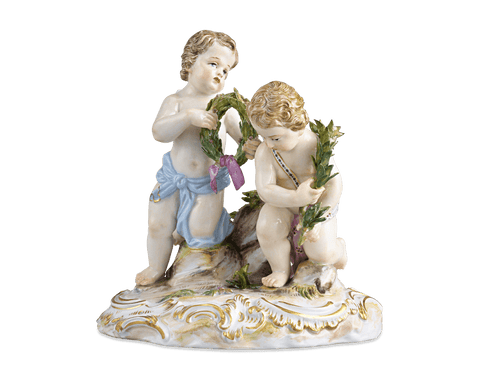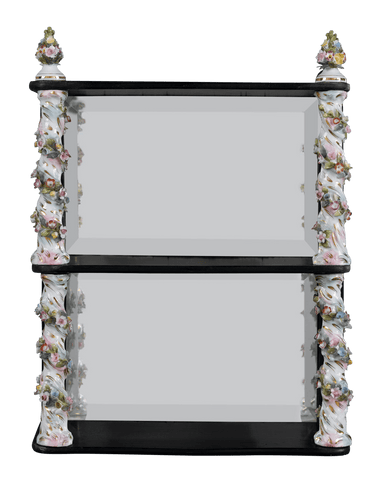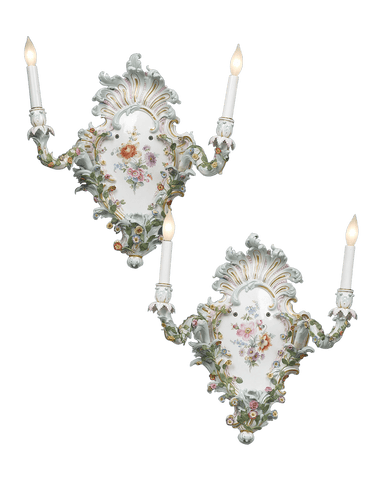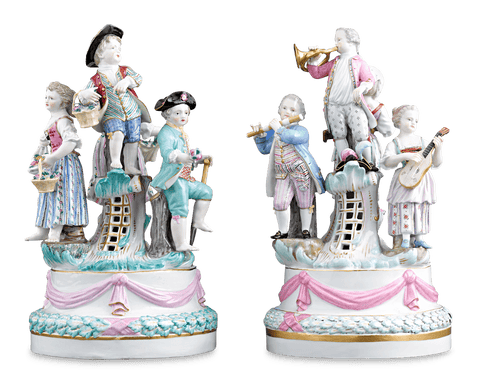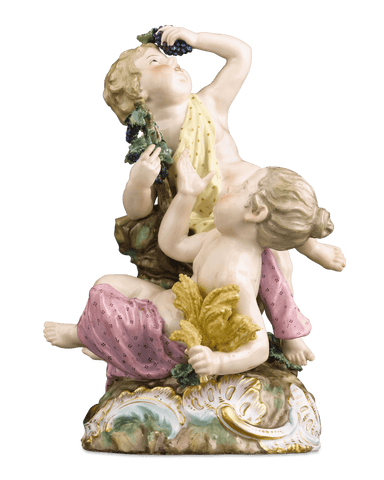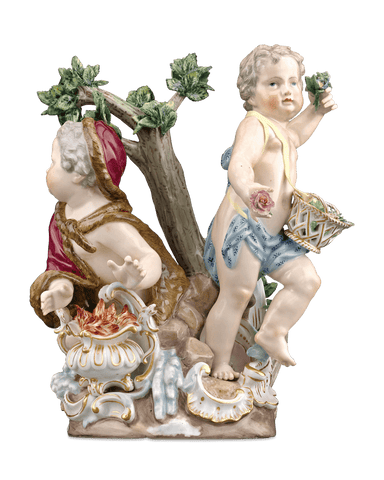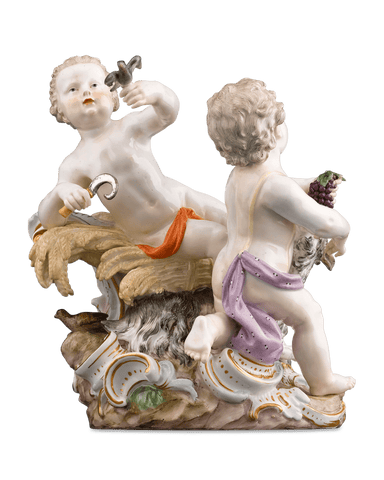Artists & Artisans
Meissen
Since the 1670s, German craftsmen sought to uncover the essential components of hard-paste porcelain akin to that of China and Japan. In 1710, the Meissen manufactory emerged near Dresden, sponsored by Augustus II, Elector of Saxony and King of Poland, becoming the pioneer in replicating the formula and arguably the most famous porcelain manufacturer worldwide.
The company held sway over European porcelain production until around 1750 when the French royal porcelain manufactory known as Sèvres rose to prominence. Meissen’s crossed swords logo was introduced in 1720 making it one of the oldest trademarks in the world, symbolizing the enduring legacy of the brand. With a prestigious history and commitment to the highest quality, Meissen remains at the forefront of fine porcelain products today.
The Alchemists Search for White Gold
By the 17th century, Chinese porcelain, along with Japanese export porcelain, had become integral to European markets, with the Dutch East India Company playing a key role in their importation. Despite its exorbitant cost upon arrival in Europe, it symbolized wealth, prestige and refined taste. European efforts to replicate porcelain proved unsuccessful.
In the early 18th century, Johann Friedrich Böttger claimed to have cracked the alchemists' dilemma by turning cheap material into gold. Upon learning of this, King Augustus II of Poland detained him and demanded the spoils of his process. Despite years of effort, Böttger failed to produce his promised gold. Meanwhile, mathematician and scientist Ehrenfried Walther von Tschirnhaus was pursuing porcelain-making for the king. His recipe included kaolin which is a vital ingredient in porcelain, yet he was not successful in his quest. Tschirnhaus oversaw Böttger, who reluctantly joined his experiments around 1707.
Just one week after his director’s death, Böttger produced a viable recipe for porcelain. In 1709, the King established the Royal-Polish and Electoral-Saxon Porcelain Manufactory, placing Böttger's laboratory at Albrechtsburg castle in Meissen and production started officially in 1710.
Böttger initially produced a robust red stoneware, known as "Böttger ware" in English, imitating Chinese Yixing ware, mainly for tea and coffee pots. While similar wares existed in the Netherlands and England, Böttger's version surpassed them in hardness and detail. Inspired by Baroque silver and Chinese ceramics, it featured crisp detailing and glossy finishes. Soon after, Meissen introduced hard-paste white porcelain suitable for glazing and painting, launching in 1713.
Böttger's experimental wares improved rapidly, though they initially struggled with painted and fired decoration. Early successes were achieved with gold ornaments, which were engraved and then subjected to a second firing. Decorative motifs in red, gold, or puce gained popularity. Johann Jakob Irminger initially spearheaded the design efforts and was succeeded by Johann Gregorius Höroldt in 1720.
Höroldt introduced vibrant overglaze colors in 1723, ushering in the classic phase of Meissen porcelain. His enamel paints have become foundational in the field of ceramic paints. The Meissen manufactory has operated its own paint laboratory since 1720. Initially, designs often mimicked Asian styles, although European landscapes were also featured.
Colorful History
The Albrechtsburg castle went to great lengths to protect the secret recipe of this white gold. To safeguard production, only a select few workers held knowledge of the porcelain-making process, and then only in parts, maintaining Meissen's monopoly on hard-paste porcelain in Europe for several years. Only the arcanists, revered as the custodians of the arcanum, meaning secret and specialized knowledge, possessed a complete understanding of the secret recipe.
One such arcanist, Samuel Stöltzel, fled to Vienna following a social scandal involving an illegitimate child, as well as a personal rivalry with fellow Meissen employee David Köhler. There, enticed by a substantial offer, he divulged the closely guarded recipe including kaolin, leading to Vienna's establishment of a rival porcelain production by 1719. Despite this, Stöltzel eventually returned to Meissen after dismantling his work in Vienna. Though welcomed back to Albrechtsburg for his expertise, he was isolated from his rival Köhler in a remote part of the castle.
Böttger, along with other scientifically minded experts searched at great lengths to perfect enamel colors to decorate their fine porcelain. The king offered a prize of 1,000 talers to anyone who discovered a recipe for blue underglaze painting. Many individuals lay claim to contributing to this recipe, but the primary contenders, David Köhler and Samuel Stöltze vied for recognition.
In 1719, they jointly presented their creation to the king, yet without conclusive evidence of either's individual contributions. Both likely played a role in its development. Yet, their competitive nature hindered collaboration, leaving the blue underglaze imperfect until Samuel Stöltzel returned from Vienna with Johann Gregorius Höroldt, an expert colorist who would become Meissen's chief painter. It was with Höroldt's expertise that the signature "Meissen Blue" underglaze was perfected in 1720. Following this, Meissen porcelain began featuring elaborate scenes depicting animals, flowers, and people, attracting Europe's premier painters and modelers under the patronage of Augustus II.
By 1760, approximately thirty European porcelain manufacturers were operating, primarily specializing in soft-paste porcelain. The superior hard-paste porcelain recipe used in Meissen products distinguished them in the market. Furthermore, Meissen added distinctive markings, initially hand-painted and later fired in underglaze blue, to further set its products apart. The original markings, such as AR and K.P.M., were superseded by the crossed swords logo in 1720, which remains one of the oldest trademarks in the world. Variations in this logo serve as approximate dating indicators.
Sculptural Period
Two prominent designers from the 1730s were Johann Gregorius Höroldt and J. J. Kaendler, who greatly influenced the distinctive Meissen style. Höroldt adorned plates, cups and saucers with intricate Baroque designs, while Kaendler crafted lifelike and dynamic figures. Together, they pioneered a fresh artistic language ushering in the so-called sculptural period. Johann Joachim Kaendler, who served as Kirchner’s assistant, succeeded him in 1733 and remained with Meissen until his death in 1775.
Kaendler emerged as Meissen's most renowned modeler and oversaw the production of small figurines and a menagerie of large-scale animals, contributing significantly to European porcelain art in the rococo style. During the Seven Years' War in 1756, Prussian occupation led to the establishment of the Royal Porcelain Manufacture Berlin. Meissen adapted to neoclassical tastes and competition from Sèvres porcelain in the 1760s, with C.W.E. Dietrich and Michel-Victor Acier leading reorganization efforts from 1763. Count Camillo Marcolini led the factory from 1774 to 1813. This era saw Meissen adopting Sèvres styles and exploring Neoclassicism, including unglazed matte biscuit porcelain resembling white marble.
Second Rococo Period
Modeler Ernst August Leuteritz modernized and reissued many rococo figurines in the nineteenth century, giving rise to a "Second Rococo" era marked by floral and lacework details, made from real lace dipped in slip and subsequently fired. Despite this revival post-1830, the factory's products were less favored by contemporary tastes than those of the 18th century. Nonetheless, Meissen attained commercial success with the 1829 introduction of the lithophane technique, which produced images visible when illuminated.Under Erich Hösel, who led the modeling department from 1903, old styles were revived and reinterpreted, including the restoration of eighteenth-century models. While some Art Nouveau pieces were produced, Meissen primarily continued making revived eighteenth-century models.
Wartime Period
After 1933, artists' freedom was restricted by the State of Saxony in line with German indoctrination. Progressive, anti-war artists such as Ernst Barlach were banned. During wartime, a lack of materials and manpower greatly impeded production. Meissen did take commissions from the Nazi government, however, Nazi party leaders set up their own alternative porcelain company, Allach, which took away from Meissen's business. After World War II, Meissen had difficulty adapting to communist ideals, as its products were luxuries and not well suited to affordable mass production. It wasn't until Karl Petermann became director in 1969 that Meissen refocused on traditions and regained artistic freedom.
Modern Meissen and Legacy
Since 1991, Meissen has been under the ownership of the State of Saxony as the sole shareholder. The company continues to produce the finest porcelain, employing a new generation of artists such as Silvia Klöde, Jörg Danielczyk, Gudrun Gaube, Olaf Fieber, Sabine Wachs and Andreas Herten. The brand produced a diverse collection of wares including dinnerware, jewelry and decorative arts while collaborating with esteemed brands such as Hugo Boss, Steiff, Supreme and Lindt.
Now over 310 years old, the brand has worldwide recognition and is the most famous porcelain producer in the world.
Quick Facts
* The King of Poland Augustus used gifts of his precious porcelain as a means of securing diplomatic alliances and representing the prestige of the court. For some time in the 1710s, this was the only way to own a Meissen work.
* The excitement felt by early porcelain collectors such as King Augustus was called Porzellankrankheit or “porcelain madness“
In 2000, the world's first organ to feature pipes made of Meissen porcelain was created under the direction of Ludwig Zepners and in collaboration with organ builders.
* One of their most renowned figurine collections is the Monkey Orchestra, an example of Singerie, derived from the French term "Monkey Trick," which represents a genre of art portraying monkeys imitating human behavior.
* Today Meissen collections are held in esteemed museums worldwide including The British Museum in London, the Zwinger in Dresden and the Metropolitan Museum of Art in New York.
Artists & Artisans
Meissen
Since the 1670s, German craftsmen sought to uncover the essential components of hard-paste porcelain akin to that of China and Japan. In 1710, the Meissen manufactory emerged near Dresden, sponsored by Augustus II, Elector of Saxony and King of Poland, becoming the pioneer in replicating the formula and arguably the most famous porcelain manufacturer worldwide.
The company held sway over European porcelain production until around 1750 when the French royal porcelain manufactory known as Sèvres rose to prominence. Meissen’s crossed swords logo was introduced in 1720 making it one of the oldest trademarks in the world, symbolizing the enduring legacy of the brand. With a prestigious history and commitment to the highest quality, Meissen remains at the forefront of fine porcelain products today.
The Alchemists Search for White Gold
By the 17th century, Chinese porcelain, along with Japanese export porcelain, had become integral to European markets, with the Dutch East India Company playing a key role in their importation. Despite its exorbitant cost upon arrival in Europe, it symbolized wealth, prestige and refined taste. European efforts to replicate porcelain proved unsuccessful.
In the early 18th century, Johann Friedrich Böttger claimed to have cracked the alchemists' dilemma by turning cheap material into gold. Upon learning of this, King Augustus II of Poland detained him and demanded the spoils of his process. Despite years of effort, Böttger failed to produce his promised gold. Meanwhile, mathematician and scientist Ehrenfried Walther von Tschirnhaus was pursuing porcelain-making for the king. His recipe included kaolin which is a vital ingredient in porcelain, yet he was not successful in his quest. Tschirnhaus oversaw Böttger, who reluctantly joined his experiments around 1707.
Just one week after his director’s death, Böttger produced a viable recipe for porcelain. In 1709, the King established the Royal-Polish and Electoral-Saxon Porcelain Manufactory, placing Böttger's laboratory at Albrechtsburg castle in Meissen and production started officially in 1710.
Böttger initially produced a robust red stoneware, known as "Böttger ware" in English, imitating Chinese Yixing ware, mainly for tea and coffee pots. While similar wares existed in the Netherlands and England, Böttger's version surpassed them in hardness and detail. Inspired by Baroque silver and Chinese ceramics, it featured crisp detailing and glossy finishes. Soon after, Meissen introduced hard-paste white porcelain suitable for glazing and painting, launching in 1713.
Böttger's experimental wares improved rapidly, though they initially struggled with painted and fired decoration. Early successes were achieved with gold ornaments, which were engraved and then subjected to a second firing. Decorative motifs in red, gold, or puce gained popularity. Johann Jakob Irminger initially spearheaded the design efforts and was succeeded by Johann Gregorius Höroldt in 1720.
Höroldt introduced vibrant overglaze colors in 1723, ushering in the classic phase of Meissen porcelain. His enamel paints have become foundational in the field of ceramic paints. The Meissen manufactory has operated its own paint laboratory since 1720. Initially, designs often mimicked Asian styles, although European landscapes were also featured.
Colorful History
The Albrechtsburg castle went to great lengths to protect the secret recipe of this white gold. To safeguard production, only a select few workers held knowledge of the porcelain-making process, and then only in parts, maintaining Meissen's monopoly on hard-paste porcelain in Europe for several years. Only the arcanists, revered as the custodians of the arcanum, meaning secret and specialized knowledge, possessed a complete understanding of the secret recipe.
One such arcanist, Samuel Stöltzel, fled to Vienna following a social scandal involving an illegitimate child, as well as a personal rivalry with fellow Meissen employee David Köhler. There, enticed by a substantial offer, he divulged the closely guarded recipe including kaolin, leading to Vienna's establishment of a rival porcelain production by 1719. Despite this, Stöltzel eventually returned to Meissen after dismantling his work in Vienna. Though welcomed back to Albrechtsburg for his expertise, he was isolated from his rival Köhler in a remote part of the castle.
Böttger, along with other scientifically minded experts searched at great lengths to perfect enamel colors to decorate their fine porcelain. The king offered a prize of 1,000 talers to anyone who discovered a recipe for blue underglaze painting. Many individuals lay claim to contributing to this recipe, but the primary contenders, David Köhler and Samuel Stöltze vied for recognition.
In 1719, they jointly presented their creation to the king, yet without conclusive evidence of either's individual contributions. Both likely played a role in its development. Yet, their competitive nature hindered collaboration, leaving the blue underglaze imperfect until Samuel Stöltzel returned from Vienna with Johann Gregorius Höroldt, an expert colorist who would become Meissen's chief painter. It was with Höroldt's expertise that the signature "Meissen Blue" underglaze was perfected in 1720. Following this, Meissen porcelain began featuring elaborate scenes depicting animals, flowers, and people, attracting Europe's premier painters and modelers under the patronage of Augustus II.
By 1760, approximately thirty European porcelain manufacturers were operating, primarily specializing in soft-paste porcelain. The superior hard-paste porcelain recipe used in Meissen products distinguished them in the market. Furthermore, Meissen added distinctive markings, initially hand-painted and later fired in underglaze blue, to further set its products apart. The original markings, such as AR and K.P.M., were superseded by the crossed swords logo in 1720, which remains one of the oldest trademarks in the world. Variations in this logo serve as approximate dating indicators.
Sculptural Period
Two prominent designers from the 1730s were Johann Gregorius Höroldt and J. J. Kaendler, who greatly influenced the distinctive Meissen style. Höroldt adorned plates, cups and saucers with intricate Baroque designs, while Kaendler crafted lifelike and dynamic figures. Together, they pioneered a fresh artistic language ushering in the so-called sculptural period. Johann Joachim Kaendler, who served as Kirchner’s assistant, succeeded him in 1733 and remained with Meissen until his death in 1775.
Kaendler emerged as Meissen's most renowned modeler and oversaw the production of small figurines and a menagerie of large-scale animals, contributing significantly to European porcelain art in the rococo style. During the Seven Years' War in 1756, Prussian occupation led to the establishment of the Royal Porcelain Manufacture Berlin. Meissen adapted to neoclassical tastes and competition from Sèvres porcelain in the 1760s, with C.W.E. Dietrich and Michel-Victor Acier leading reorganization efforts from 1763. Count Camillo Marcolini led the factory from 1774 to 1813. This era saw Meissen adopting Sèvres styles and exploring Neoclassicism, including unglazed matte biscuit porcelain resembling white marble.
Second Rococo Period
Modeler Ernst August Leuteritz modernized and reissued many rococo figurines in the nineteenth century, giving rise to a "Second Rococo" era marked by floral and lacework details, made from real lace dipped in slip and subsequently fired. Despite this revival post-1830, the factory's products were less favored by contemporary tastes than those of the 18th century. Nonetheless, Meissen attained commercial success with the 1829 introduction of the lithophane technique, which produced images visible when illuminated.Under Erich Hösel, who led the modeling department from 1903, old styles were revived and reinterpreted, including the restoration of eighteenth-century models. While some Art Nouveau pieces were produced, Meissen primarily continued making revived eighteenth-century models.
Wartime Period
After 1933, artists' freedom was restricted by the State of Saxony in line with German indoctrination. Progressive, anti-war artists such as Ernst Barlach were banned. During wartime, a lack of materials and manpower greatly impeded production. Meissen did take commissions from the Nazi government, however, Nazi party leaders set up their own alternative porcelain company, Allach, which took away from Meissen's business. After World War II, Meissen had difficulty adapting to communist ideals, as its products were luxuries and not well suited to affordable mass production. It wasn't until Karl Petermann became director in 1969 that Meissen refocused on traditions and regained artistic freedom.
Modern Meissen and Legacy
Since 1991, Meissen has been under the ownership of the State of Saxony as the sole shareholder. The company continues to produce the finest porcelain, employing a new generation of artists such as Silvia Klöde, Jörg Danielczyk, Gudrun Gaube, Olaf Fieber, Sabine Wachs and Andreas Herten. The brand produced a diverse collection of wares including dinnerware, jewelry and decorative arts while collaborating with esteemed brands such as Hugo Boss, Steiff, Supreme and Lindt.
Now over 310 years old, the brand has worldwide recognition and is the most famous porcelain producer in the world.
Quick Facts
* The King of Poland Augustus used gifts of his precious porcelain as a means of securing diplomatic alliances and representing the prestige of the court. For some time in the 1710s, this was the only way to own a Meissen work.
* The excitement felt by early porcelain collectors such as King Augustus was called Porzellankrankheit or “porcelain madness“
In 2000, the world's first organ to feature pipes made of Meissen porcelain was created under the direction of Ludwig Zepners and in collaboration with organ builders.
* One of their most renowned figurine collections is the Monkey Orchestra, an example of Singerie, derived from the French term "Monkey Trick," which represents a genre of art portraying monkeys imitating human behavior.
* Today Meissen collections are held in esteemed museums worldwide including The British Museum in London, the Zwinger in Dresden and the Metropolitan Museum of Art in New York.
